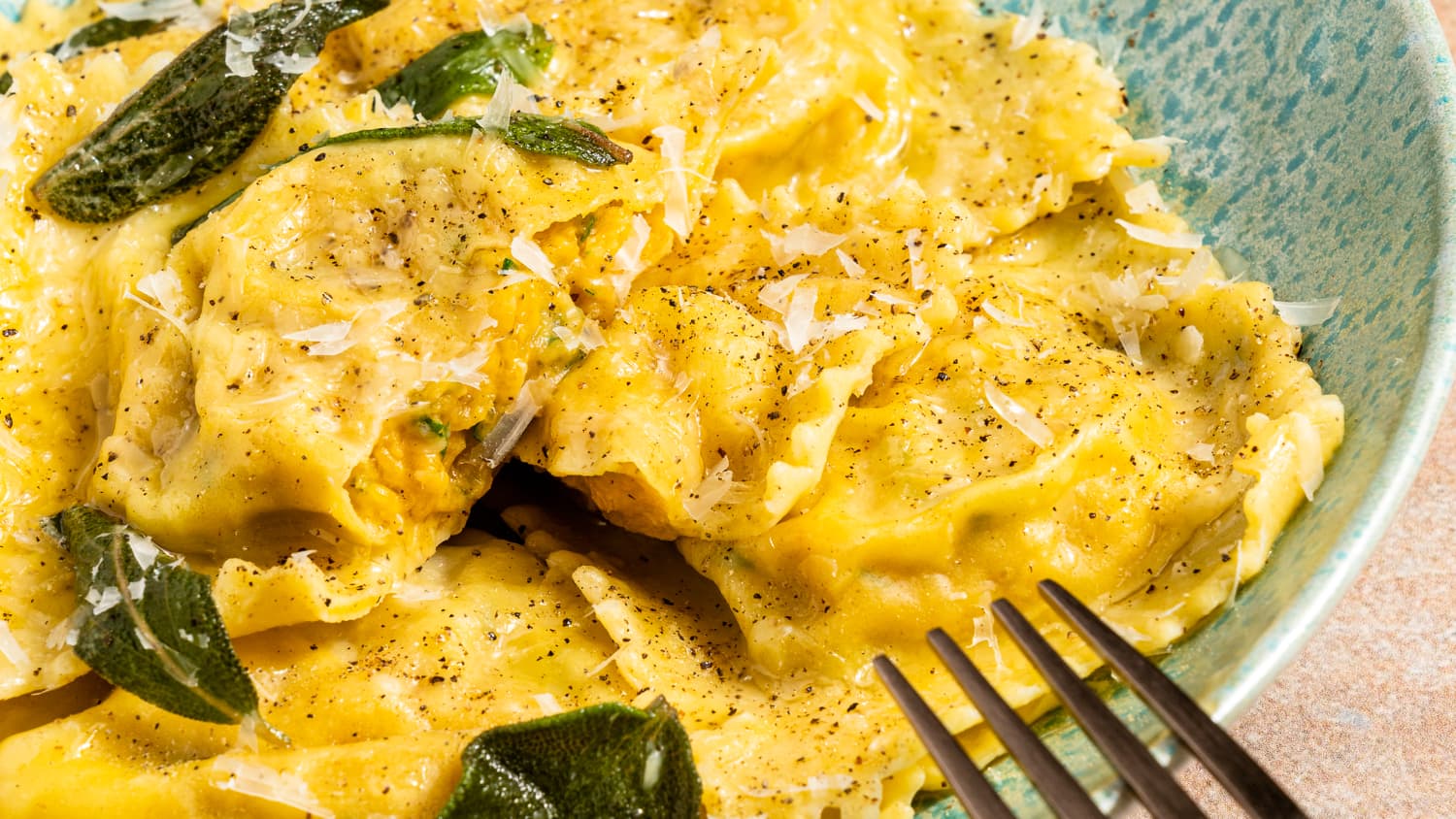Butternut Squash Ravioli Recipe
Your folders
Your folders
Prep Time: 0.75 hours
Cook Time: 30 minutes
Servings: 6
Author : Kristina Vanni

Ingredients
Export 13 ingredients for grocery delivery
Instructions
Step 1
Place 7 large egg yolks, 1 large egg, 2 teaspoons olive oil, and 1 1/2 teaspoons milk in a medium bowl and whisk to combine.
Step 2
Place 1 1/2 cups all-purpose flour on a clean countertop, pasta board, or a large bowl with a wide base and shape into a mound. Make a wide well in the center of the mound. Slowly pour some of the egg mixture into the well. Stir the egg mixture with a fork, gradually incorporating some of the flour from the sides of the well. Make sure the wall of flour surrounding the eggs doesn’t collapse. Continue stirring, incorporating the flour mixture gradually from the inside of the well toward the outside out until everything is combined and it forms a ball.
Step 3
Lightly flour your hands and knead the dough to gradually incorporate any remaining flour on the surface until the dough feels moist, somewhat smooth, and slightly sticky, about 3 minutes. Avoid adding too much extra flour or the pasta will become too dry.
Step 4
Scrape the work surface clean if needed to remove any hardened scraps of dough or excess flour. Lightly dust your hands with flour again and continue to knead the dough until smooth, elastic, and not sticky. (It shouldn’t be too much of a challenge to knead. You should feel like a kid again, simply enjoying playing with your Play-Doh.) This will take anywhere from a few minutes to 10 minutes. The dough is ready when there are no streaks of flour and the color is an even yellow hue.
Step 5
Invert a bowl over the dough or cover with a piece of plastic wrap. Let rest for at room temperature for at least 30 minutes or up to 2 hours to allow the gluten to relax. Meanwhile, make the filling.
Step 6
Finely dice 1 medium shallot (about 1/3 cup). Finely chop 1/4 cup fresh parsley leaves.
Step 7
Heat 2 tablespoons olive oil in a large saucepan over medium-high heat until shimmering. Add the shallot and 4 cups cubed butternut squash, and sauté until the shallot is translucent, about 5 minutes.
Step 8
Add 1/2 cup water and reduce the heat to medium. Partially cover the pan and cook, stirring occasionally, until the butternut squash is tender, 15 to 25 minutes. Completely uncover during the last few minutes of cooking to let cook off the liquid. (If all the water evaporates before the squash is tender, add 1/4 cup more as needed.) Remove from the heat and let cool slightly. Mash with a potato masher until smooth. If the mixture seems wet, cook over low heat until the extra moisture is cooked off.
Step 9
Add the parsley, 2/3 cup grated Parmesan cheese, 1 large egg, 1 teaspoon kosher salt, 1/4 teaspoon black pepper, and 1/4 teaspoon ground nutmeg. Stir to combine.
Step 10
Bring a large pot of heavily salted water to a boil. Cut the pasta dough into 4 pieces. Roll the dough out one at a time (keep the other pieces covered so they don't dry out) through a pasta roller according to the manufacturer's directions until you can easily see your hand through the sheet when held up to the light. (The size of each sheet will depend on your machine; my strips ended up about 5 inches wide and 24 inches long.)
Step 11
Have a small bowl of cold water ready. Lay one sheet of dough on a lightly floured work surface. Beginning 1 inch from a short end, drop teaspoonfuls of the filling about 1 inch apart in a straight row lengthwise down one half of the dough. Lightly brush the water around the each spoonful of filling. Fold the dough in half lengthwise over the filling. Press out any air bubbles, then seal the edges by pressing down on the dough with your fingers.
Step 12
Use a sharp knife, fluted pastry wheel, or ravioli cutter to cut between the mounds of filling to cut out individual ravioli. Separate the ravioli and press the edges with the tines of a fork to firmly to seal. Place the ravioli in a single layer on a lightly floured baking sheet and cover with a towel as you work. Repeat with the remaining dough and filling.
Step 13
Place 1 stick unsalted butter and 10 fresh sage leaves in a medium saucepan and melt over low heat. Taste and season with kosher salt and black pepper as needed. Keep warm over very low heat.
Step 14
Reduce the heat on the pot of boiling water to a gentle simmer. Working in batches, add the ravioli and cook until they float to the surface, about 5 minutes. Remove from the pot with a slotted spoon and drain well before placing in a serving bowl.
Step 15
To serve, spoon the sage butter over the ravioli. Top with freshly grated Parmesan cheese and eat immediately.